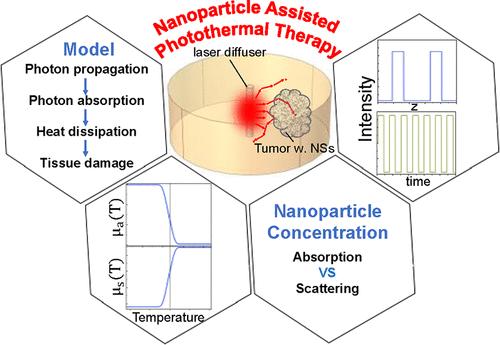当前位置:
X-MOL 学术
›
ACS Photonics
›
论文详情
Our official English website, www.x-mol.net, welcomes your feedback! (Note: you will need to create a separate account there.)
Routes to Optimizing Photothermal Cancer Therapy through a Comprehensive Theoretical Model
ACS Photonics ( IF 6.5 ) Pub Date : 2024-06-26 , DOI: 10.1021/acsphotonics.4c00491 Gopal Narmada Naidu 1, 2, 3 , Yara Kadria-Vili 3, 4 , Oara Neumann 3, 5 , Naomi J. Halas 1, 3, 4, 5 , Peter Nordlander 1, 3, 5 , Alessandro Alabastri 3, 5
ACS Photonics ( IF 6.5 ) Pub Date : 2024-06-26 , DOI: 10.1021/acsphotonics.4c00491 Gopal Narmada Naidu 1, 2, 3 , Yara Kadria-Vili 3, 4 , Oara Neumann 3, 5 , Naomi J. Halas 1, 3, 4, 5 , Peter Nordlander 1, 3, 5 , Alessandro Alabastri 3, 5
Affiliation

|
Nanoparticle-assisted photothermal therapy is a soft tissue ablation method where nanoparticles embedded in tissue absorb near-infrared light, converting it to heat and raising temperatures directly where the nanoparticles are located, with minimal damage to adjacent tissue. Developing a method that accurately predicts light and heat dissipation within both pristine and nanoparticle-embedded tissues is essential for making this process as efficient as possible. Here, we report a theoretical model of nanoparticle-assisted photothermal therapy that provides a deeper understanding of this process. The model considers light scattering and absorption by tissue and nanoparticles, resulting in heat generation and dissipation. We find that the thermal response is a consequence of two competing processes, increased light absorption and backscattering, both dependent on nanoparticle concentration, and we accurately account for temperature-dependent tissue properties. Through this approach, we found that spatial and temporal modulation of the laser intensity, combined with heat localization, can dramatically increase the efficiency of the ablation process, resulting in a 44% greater ablation volume in 33% less illumination time. Our critical examination of this therapeutic approach through a robust, data-validated model offers valuable insights into practical strategies for potentially game-changing treatment optimization.
中文翻译:

通过综合理论模型优化光热癌症治疗的途径
纳米颗粒辅助光热疗法是一种软组织消融方法,其中嵌入组织中的纳米颗粒吸收近红外光,将其转化为热量并直接升高纳米颗粒所在位置的温度,对邻近组织的损伤最小。开发一种能够准确预测原始组织和纳米粒子嵌入组织内的光和热耗散的方法对于使该过程尽可能高效至关重要。在这里,我们报告了纳米颗粒辅助光热疗法的理论模型,可以更深入地了解这一过程。该模型考虑了组织和纳米颗粒的光散射和吸收,从而导致热量的产生和消散。我们发现热响应是两个竞争过程的结果,即增加的光吸收和反向散射,两者都取决于纳米颗粒的浓度,并且我们准确地解释了与温度相关的组织特性。通过这种方法,我们发现激光强度的空间和时间调制与热定位相结合,可以显着提高烧蚀过程的效率,从而在减少 33% 的照明时间的情况下,使烧蚀体积增加 44%。我们通过强大的、经过数据验证的模型对这种治疗方法进行了严格的检查,为可能改变游戏规则的治疗优化的实际策略提供了宝贵的见解。
更新日期:2024-06-27
中文翻译:

通过综合理论模型优化光热癌症治疗的途径
纳米颗粒辅助光热疗法是一种软组织消融方法,其中嵌入组织中的纳米颗粒吸收近红外光,将其转化为热量并直接升高纳米颗粒所在位置的温度,对邻近组织的损伤最小。开发一种能够准确预测原始组织和纳米粒子嵌入组织内的光和热耗散的方法对于使该过程尽可能高效至关重要。在这里,我们报告了纳米颗粒辅助光热疗法的理论模型,可以更深入地了解这一过程。该模型考虑了组织和纳米颗粒的光散射和吸收,从而导致热量的产生和消散。我们发现热响应是两个竞争过程的结果,即增加的光吸收和反向散射,两者都取决于纳米颗粒的浓度,并且我们准确地解释了与温度相关的组织特性。通过这种方法,我们发现激光强度的空间和时间调制与热定位相结合,可以显着提高烧蚀过程的效率,从而在减少 33% 的照明时间的情况下,使烧蚀体积增加 44%。我们通过强大的、经过数据验证的模型对这种治疗方法进行了严格的检查,为可能改变游戏规则的治疗优化的实际策略提供了宝贵的见解。






































 京公网安备 11010802027423号
京公网安备 11010802027423号